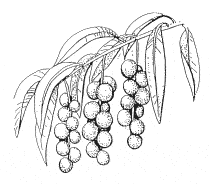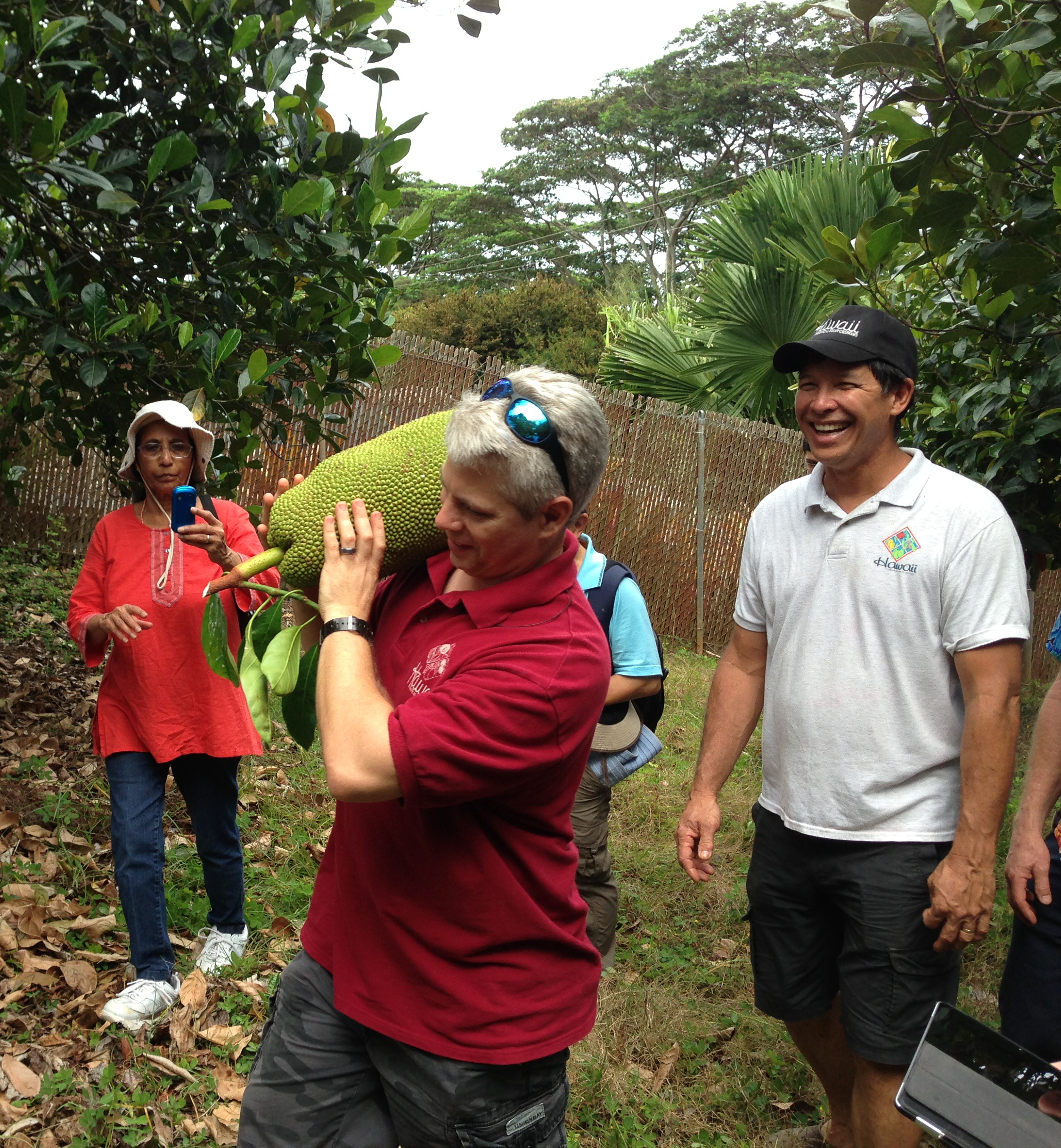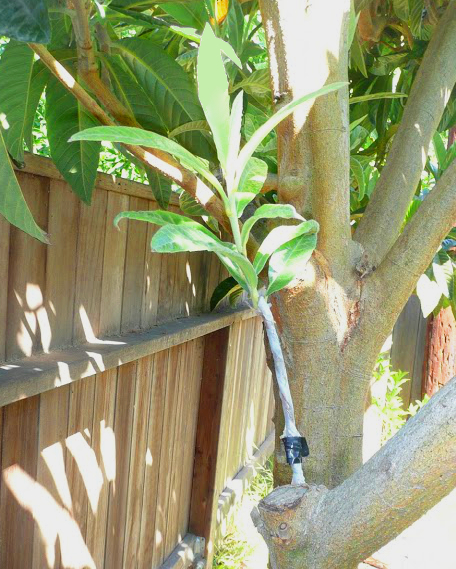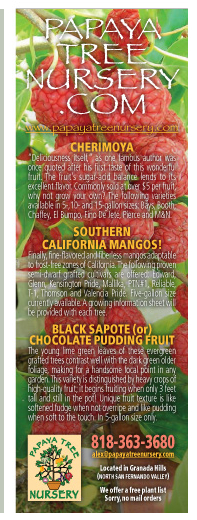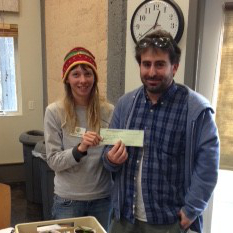LOQUAT
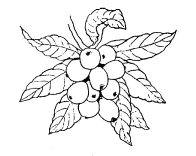
Eriobotrya japonica Lindl.
Rosaceae
Common Names: Loquat, Japanese medlar, Nispero.
Distant Affinity: Apples (Malus spp.), Medlar (Mispilus germanica), Stone Fruit (Prunus spp.), Pears (Pyrus spp.) and others.
Origin: The loquat is indigenous to southeastern China. It was introduced into Japan and became naturalized there in very early times. It has been cultivated in Japan for over 1,000 years. It has also become naturalized in India and many other areas. Chinese immigrants are presumed to have carried the loquat to Hawaii. It was common as a small-fruited ornamental in California in the 1870’s, and the improved variety, Giant, was being sold there by 1887. Japan is the leading producer of loquats, followed by Israel and Brazil.
Adaption: The loquat is adapted to a subtropical to mild-temperature climate. Where the climate is too cool or excessively warm and moist, the tree is grown as an ornamental but will not bear fruit. Well established trees can tolerate a low temperature of 12° F. The killing temperature for the flower bud is about 19° F, and for the mature flower about 26° F. At 25° F the seed is killed, causing the fruit to fall. Extreme summer heat is also detrimental to the crop, and dry, hot winds cause leaf scorch. High heat and sunlight during the winter often results in sunburned fruit. The white-fleshed varieties are better adapted to cool coastal areas. In a large tub the loquat makes a good container specimen.
DESCRIPTION
Growth Habits: The loquat is a large evergreen shrub or small tree with a rounded crown, short trunk and woolly new twigs. The tree can grow 20 to 30 ft. high, but is usually much smaller than this–about 10 ft. Loquats are easy to grow and are often used as an ornamental. Their boldly textured foliage add a tropical look to the garden and contrast well with many other plants. Because of the shallow root system of the loquat, care should be taken in mechanical cultivation not to damage the roots.
Foliage: Loquat leaves are generally eliptical-lanceolate, 5 to 12 inches long and 3 to 4 inches wide. They are dark green and glossy on the upper surface, whitish or rusty-hairy beneath, thick and stiff, with conspicuous parallel, oblique veins. The new growth is sometimes tinged with red. The leaves are narrow in some cultivars and broad in others.
Flowers: Small, white, sweetly fragrant flowers are borne in fall or early winter in panicles at the ends of the branches. Before they open, the flower clusters have an unusual rusty-wooly texture.
Fruit: Loquat fruits, growing in clusters, are oval, rounded or pear-shaped, 1 to 2 inches long with a smooth or downy, yellow or orange, sometimes red-blushed skin. The succulent, tangy flesh is white, yellow or orange and sweet to subacid or acid, depending on the cultivar. Each fruit contains three to five large brown seeds. The loquat is normally pollinated by bees. Some cultivars are self-infertile and others are only partially self-fertile. Flowers of the early and late flushes tend to have abnormal stamens and very little viable pollen. Thinning of flowers and young fruits in the cluster, or clipping off all or part of flower and fruit clusters is sometimes done to enhance fruit size. Under most conditions the loquat tends to develop an alternate-bearing pattern, which can be modified somewhat by cluster thinning in heavy production years. For the highest quality fruit the clusters are sometimes bagged to protect from sunburn and eliminate bird damage.
CULTURE
Location: Loquats are wind tolerant and grow best in full sun, but also do well in partial shade. The round headed trees can be used to shade a patio. Loquats also make attractive espaliers.
Soil: Loquats grow well on a variety of soils of moderate fertility, from light sandy loam to heavy clay and even limestone soils, but need good drainage.
Irrigation: Loquat trees are drought tolerant, but they will produce higher quality fruit with regular, deep watering. The trees should be watered at the swelling of blossoms and 2 to 3 waterings should be given during harvest time. The trees will not tolerate standing water.
Fertilizing: Loquats benefit from regular, light applications of nitrogen fertilizers, but too much nitrogen will reduce flowering. A good formula for applications of chemical fertilizer is 1 lb. of 6-6-6 NPK three times a year during the period of active growth for each tree 8 to 10 feet in height. To control excessive growth, other authorities recommend fertilizing only once a year in midwinter.
Pruning: Judicious pruning should be done just after harvest, otherwise terminal shoots become too numerous and cause a decline in vigor. The objective of pruning is a low head to facilitate fruit thinning and harvest. Prune also to remove crossing branches and thin dense growth to let light into the center of the tree. Loquats respond well to more severe pruning.
Propagation: Generally seeds are used for propagation only when the tree is grown for ornamental purposes or for use as rootstock. For rootstock the seed are washed and planted in flats or pots soon after removal from the fruit and the seedlings are transplanted when 6 to 7 inches high. When the stem is 1/2 inch thick at the base, the seedlings are ready to be top-worked. Loquats can be propagated by various grafting methods, including shield-budding or side-veneer grafting and cleft-grafting. The use of loquat seedling rootstock usually results in a comparatively large tree with a high canopy. Cultivars grown on quince rootstock produce a dwarfed tree of early bearing character. The smaller tree has no effect on fruit size and gives adequate fruit production with the advantage of easier picking. Loquat cuttings are not easy to root. Grafted trees will begin to bear fruit in 2 to 3 years, compared to 8 to 10 years in seedling trees.
Pests and Diseases: In California there are few pests that bother loquats. Occasionally infestations of black scale may appear. Fruit flies are a serious pests in areas where they are problem. Birds will also peck at the ripe fruit and damage it, and deer will browse on the foliage.
Fire blight caused by Erwinia amylovora is a major enemy of the loquat in California, particularly in areas with late spring and summer rains or high humidity. The disease is spread by bees during flowering. Fire blight can be controlled somewhat by the use of preventive fungicides or bactericides and by removal of the the scorched-looking branches, cutting well into live wood. The prunings should be burned or or sealed in a plastic bag before disposal. Crown rot caused by Phytophthora and cankers caused by Pseudomonas Eriobotrya are also occasional problems.
Harvest: Loquat fruits should be allowed to ripen fully before harvesting. They reach maturity in about 90 days from full flower opening. When ripe the fruit develops a distinctive color, depending on the cultivar, and begins to soften. Unripe fruits do not ripen properly off the tree and are excessively acid. Harvest time in California is from March to June. The fruit is difficult to separate from the cluster stems without tearing and must be carefully clipped individually or the whole cluster removed and the fruit then snipped off. Ripe fruit may be stored in the refrigerator for 1 to 2 weeks.
The loquat is comparable to the apple in many aspects, with a high sugar, acid and pectin content. It is eaten as a fresh fruit and mixes well with other fruits in fresh fruit salads or fruit cups. Firm, slightly immature fruits are best for making pies or tarts. The fruits are also commonly used to make jam, jelly and chutney, and are delicious poached in light syrup. Loquats can also be used to make wine.
Commercial Potential: In California, only in the coastal areas from Santa Barbara to San Diego counties is the fruit produced regularly in quantity and of sufficiently good quality to make commercial production feasible. Harvesting is somewhat labor intensive and the difficulty of handling the fragile fruit in addition to the relatively short self life and storage ability, limit the loquat as a major commercial fruit. Even so, the availability of loquats when few or no other local fruits are in the market is a factor in their favor. The fruit is also popular in ethnic markets and is offered in limited amounts in specialty fruit stores and through Farmer’s Markets in many communities.
CULTIVARS
Orange-fleshed Varieties
- Big Jim
- Originated in San Diego, Calif. by Jim Neitzel. Large, roundish to oblong fruit, 1-1/4 to 1-1/2 inches in diameter. Skin pale orange-yellow, medium-thick, easy to peel. Flesh orange-yellow, very sweet but with some acidity, of excellent flavor. Ripens midseason, March to April. Tree vigorous, upright, highly productive.
- Early Red
- Originated by C. P. Taft in 1909. Medium-large, pear-shaped fruit, borne in compact clusters. Skin orange-red with white dots, tough, acid. Flesh orange very juicy, sweet, of fair to excellent flavor. Seeds usually 2 or 3. Ripens very early, late January or early February in California.
- Gold Nugget (Thales, Placentia)
- Large, round to oblong-obovate fruit. Skin yellow-orange to orange, not thick, tender. Flesh orange-colored, juicy, firm and meaty. Flavor sweet, somewhat reminiscent of apricot, quality good. Seeds 4 or 5, the seed cavity not large. Ripens late. Fruits borne only a few to a cluster, keep and ship well. Tree vigorous, upright, self-fertile.
- Mogi
- Selected from numerous seedlings planted at Mogi, Japan. Small, elliptical fruit, weight 40-50 grams. Skin light yellow. Flesh relatively sweet. Ripens in early spring. Tree cold-sensitive, self-fertile. Constitutes 60% of the Japanese crop of loquats.
- Mrs. Cooksey
- New Zealand cultivar. Large fruit, up to 1-1/2 inches long and 1 inch in diameter. Yellow flesh of very good flavor.
- Strawberry
- Medium-sized fruit with yellow flesh. Named for the strawberry-like flavor detected by some tasters.
- Tanaka
- Named after Dr. Yoshio Tanaka. Very large fruit, usually obovoid, weight 2 to 3 ounces. Skin orange-yellow, attractive. Flesh firm, rich orange, aromatic, slightly acidic to sweet, of excellent flavor. Seeds 2 to 4. Ripens very late, the beginning of May in California. Keeps unusually long, if left for a week it wrinkles and dries but does not rot. Tree vigorous and productive.
- Wolfe
- Originated in Homestead, Florida by Carl W. Campbell. Fruit obovoid to slightly pyriform. Skin yellow, relatively thick. Flesh juicy, firm, flavor excellent. Seeds usually 1 to 3. Ripens in winter and early spring, several days later than Advance. Suitable for all purposes, but excellent for cooking. Tree to 25 feet tall. Blooms during fall and early winter.
White-fleshed Varieties
- Advance
- Medium to large, pear-shaped to eliptic-round fruit, deep yellow in color, borne in large, compact clusters. Skin downy, thick and tough. Flesh whitish, translucent, melting and very juicy. Flavor subacid, very pleasant, quality good. Ripens in midseason. Seeds commonly 4 or 5, the seed cavity not large. Tree is a natural dwarf, height 5 feet. Highly resistant to fire blight. Self-infertile, pollinate with Gold Nugget.
- Benlehr
- Originated as a seedling on the property of Charles E. Benlehr of Encinitas, Calif. Medium-sized oval to oblong fruit, 1-1/2 to 1-3/4 inches long. Skin thin, peels very well. Flesh white and juicy, flavor sweet, quality excellent. Seeds 3 or 4.
- Champagne
- Fruit medium to large, oval to pyriform. Fruit cluster large, loose. Skin deep yellow in color with a grayish bloom, thick, tough, somewhat astringent. Flesh whitish, translucent, melting and very juicy. Flavor mildly subacid, sprightly and pleasant, quality very good. Ripens late. Seeds 3 or 4, seed cavity not large. Perishable, good for preserving. Tree self-infertile, prolific.
- Herd’s Mammoth
- Fruit large, long and slightly tapering at the stem end. Flesh yellow orange with white to cream-colored flesh, good quality. Ripens earlier than Victory. Subject to black spot.
- Victory (Chatsworth Victory)
- Large, oval fruit. Skin yellow to orange, becoming amber on the side exposed to the sun. Flesh white to cream-colored, juicy and sweet. Ripens in midseason to occasionally early. The most popular cultivar in Western Australia.
- Vista White
- Small to medium-sized, roundish fruit with blunt calyx end. Skin light yellow. Flesh pure white, very high in sugar content. Ripens 1 to 3 weeks later than Gold Nugget. Excellent for dessert.
FURTHER READING
- Butterfield, Harry M. A History of Subtropical Fruits and Nuts in California. University of California, Agricultural Experiment Station. 1963.
- Facciola, Stephen. Cornucopia: a Source Book of Edible Plants. Kampong Publications, 1990. p. 380.
- Johns, Leslie and Violet Stevenson, Fruit for the Home and Garden. Angus and Robertson, 1985. pp. 159-161.
- Morton, Julia F. Fruits of Warm Climates. Creative Resources Systems, Inc. 1987. pp. 103-108.
- Ortho Books. All About Citrus and Subtropical Fruits. Chevron Chemical Co. 1985. pp. 57-58.
© Copyright 1997, California Rare Fruit Growers, Inc.


